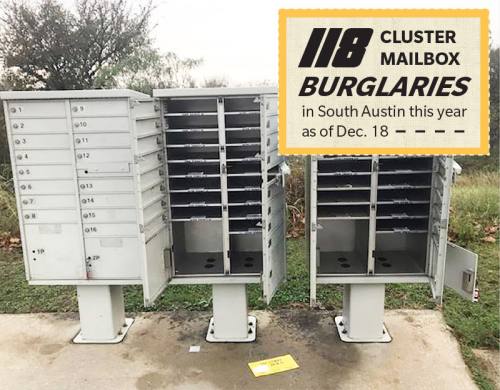As burglaries of cluster mailboxes continue to occur in South Austin, residents and homeowners associations are banding together to try to prevent future break-ins.
On Dec. 12, Kevin Cooper, secretary of the Barker Ranch at Shady Hollow HOA, held a meeting that brought together neighborhood representatives; Michael Sullivan, the U.S. Postal Inspector for the Central Texas area; and liaisons from the offices of U.S. Sen. Ted Cruz and U.S. Reps. Lamar Smith and Roger Williams. Rather than relying solely on the postal service, Cooper said he hoped to identify a regional approach to tackling the burglaries.
“I have dealt with the U.S. Postal Service before, and I know how hard it can be,” he said. “We are all a community; I don’t care which neighborhood I live in. In order to get something done, we have to band together to stop these thieves. The best way to do that is to share our experiences and get someone to listen.”
Between Jan. 1 and Dec. 18, 2017, 118 cluster mailbox burglaries were reported in South Austin, according to postal service data revealed through a Freedom of Information Act request submitted by
Community Impact Newspaper. The pattern of citywide mailbox break-ins began in fall 2015, Sullivan said, but in South Austin the crime picked up speed earlier this year. Sullivan suspects there is no correlation between the crime and South Austin other than the possibility that offenders live in the area.
“[The thieves] are successful in South Austin; otherwise they would move on,” he said.
REPLACING THE BOXES
To minimize vulnerability, Sullivan said he has met with several neighborhoods to share prevention tips, such as retrieving mail daily or having valuable items delivered to a resident’s place of work.
But many South Austinites argue the issue is not neglect on the part of residents, but rather poorly engineered mailboxes. Aging units made of flimsy aluminum originally designed to protect mail from the elements were not intended to deter a “determined person with a crowbar,” Sullivan said.
“If [the cluster mailboxes] are not broken into, they are falling apart, rusted out, not maintained and vandalized,” said Dee Bandini, a resident of Buckingham Estates. “It’s just insane.”
When replacing a mailbox, the question of which entity is responsible for the infrastructure often comes into play. According to Sullivan, though the postal service owns the unit’s locking mechanism, the mailbox itself is generally purchased and owned by the community. Still, because the postal service’s reputation relies on the convenience of receiving mail, it behooves the entity to repair damaged boxes.
“We want to deliver the mail, so if we can come out and repair it, we will do it,” he said.
Replacing a cluster mailbox with a stronger, more burglary-proof version costs around $1,200, Sullivan said. And while the postal service plans to upgrade the 12,000 cluster boxes citywide, that process is going to “take some time,” Sullivan said.
NEIGHBORHOODS STEP IN
Rather than waiting on the postal service, some HOAs have chosen to absorb the cost of new boxes on their own. Following a slew of burglaries in Circle C Ranch, in 2016 its HOA decided to move forward with replacing all existing rear-opening boxes with stronger versions—an expense manager Karen Hibpshman said cost the association upwards of $150,000.
“The question had been raised to our post office about replacing the boxes, and we were told they didn’t have the money,” she said. “So the board went out and got quotes on rear-opening mailboxes. It was designed as a three-year project, but the board voted to instead move forward and complete the boxes all at one time.”
And although the investment has greatly decreased burglaries, it has not completely eradicated them, according to resident John Kaiser, who said his cluster mailbox was broken into just two months ago.
Repair of Kaiser’s mailbox took three weeks, he said. According to the postal service, under normal circumstances the time frame for cluster mailbox repairs or replacements is between three and seven days; however, with the recent surge in incidences of vandalism, repair time has increased to approximately one month.
“I kept asking the postal service [about the repair], and they kept saying they were waiting for parts to come in,” Kaiser said.
In cases of prolonged repair times, residents are forced to retrieve their mail from the local post office, where long lines and overworked postal service staff creates another inconvenience.
“It should never take a month to get boxes repaired,” Sullivan said. “That is a failure in communication and in the post office.”
Tammy Whitehead said it took nearly three weeks for the cluster mailbox units in her Olympic Heights neighborhood to be repaired after a burglary occurred Nov. 13. During that period, Whitehead picked up her mail from the post office on Manchaca Road.
“I only ended up going once a week because of the ordeal,” she said. “I timed it and it took 45 minutes from when I got in line until I left. There were five people in front of me, but by the time I left there were about 10 people behind me.”
Most residents agree the best prevention method is a widespread upgrade of older boxes, but the responsibility belongs to the postal service.
“My community can’t afford to buy new boxes,” said Travis Wesley, South Austin resident and president of the Citizen Led Austin Safety Partnership. “Why should we have to do that? We all pay our taxes.”
SHORT-TERM SOLUTIONS
Some neighborhoods lack the resources to purchase new boxes, and others are bereft of any sort of leadership entity, leading some residents to devise less expensive or free ways to monitor mailboxes.
After a succession of burglaries plagued the Sendera neighborhood, homeowners association President Angie Flores said she and her neighbors inquired with their management company to see what could be done.
“The postal service told us that we could replace [the cluster mailboxes], but then managing upkeep becomes our responsibility,” Flores said. “As an HOA, that is probably not an expense we could incur at this point.”
Instead, Flores said her HOA is looking into improved lighting around the boxes, as well as increased neighborhood watch.
Wesley agreed that when crime begins to sweep a community, it is in part the responsibility of residents to lend a hand to law enforcement—especially during a time when he says the Austin Police Department is underfunded and understaffed.
Mail theft is a federal crime, so local police do not have the ability to launch an investigation, according to the APD Region 4 Sgt. Noel Guerin, who oversees property crime in South Austin
The department’s job is to keep track of and report all mail theft to the postal service, Guerin said, which it does through calls to 311 and 911.
Another short-term solution implemented by the postal service is sealing the outgoing mail slot on units that have been vulnerable to crime. According to South Austin residents, burglars are using the outgoing mail slot to pry open the panel mechanism—allowing access to the entire unit.
MOVING FORWARD
To address the issue of slow repairs, the postal service said it has instituted a new tracking system to help expedite identification of cluster mailboxes in need of maintenance.
The postal service spent over $100,000 just this summer on replacing aluminum mailboxes citywide, Sullivan said, and is upgrading its assets to try to deter future attacks.
“[Reducing mailbox burglaries] is what we want for the convenience of our customers and for the business of the postal service,” Sullivan said.










